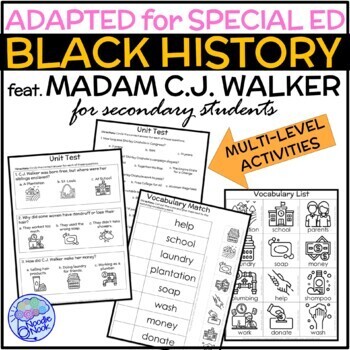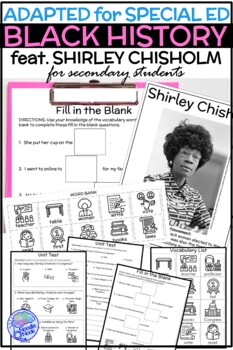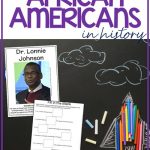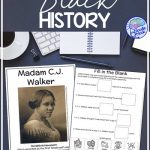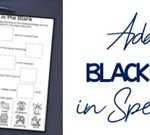Adapted black history activities for special ed have a place in our classrooms beyond just February for Black History Month.
Moreover, learning about black history should extend past MLK, Jr. and Rosa Parks.
While both were icons and civil rights legends, African-Americans have contributed to society in so many ways outside of what we narrowly focus on in school.
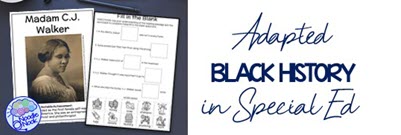
With that in mind, I wanted to offer teachers adapted Black history activities for Special Ed students with disabilities. I tried featuring less discussed yet important Black people in history. People who changed our lives by living beyond expectations or labels.
That sounds all well and good to most of us… like, ‘Yeah! Let’s focus on important Black people in history without reading another story about MLK!’ In practice, however, most of us who actually teach secondary special ed know we need hands-on adapted activities AND differentiated tasks to meet the needs of our students. On top of that, we DON’T want anything too babyish or cartoon-ish. For our older students that can be very infantilizing and a little embarrassing. If this sounds like you and your students, then I have the perfect adapted black history activities for you!
Black History Unit
Sometimes it can feel like you find a great activity, get it, and then realize you need to find a whole bunch more stuff to actually make it work in the classroom. Geez.
These adapted Black history activities for Special Ed come bundled in units. Each unit comes with everything you need!
There are lesson plans for a whole week and all the materials you need to make everything happen. That makes these the perfect sub plans in addition to a great week-long history unit.
There are 5 large group activities for everyone in each unit. Most of these differentiated activities include an icon-supported version as well as a standard version. There’s no ‘dumbing down’ here either. You teach secondary, right? These have on-level ideas, just with adapted activities to support students with disabilities.
PLUS there are ten small group station activities, two for each day, with each unit. In my classroom over the past several years and at several different levels, I’ve found it is easier to teach smaller groups of people than the entire class at once, especially when it comes to students with disabilities.
You can approach this in a few different ways. I outline those ways in my post “How to Set Up Station-Rotations in Secondary Special Ed”, so check that out.
FINALLY, the best part of this printable is that it includes graphic organizers, comprehension activities, writing activities, vocabulary activities, teaching materials and extension activities for those fast finishers too. Whoop-whoop!
Check out the full printable bundle for each unit (Thurgood Marshall, Shirley Chisholm, Lonnie Johnson, and Madam C.J. Walker) by clicking the button below. Remember, each unit comes with all you see above and the bundle can cover your social studies curriculum for an entire month. That means your Black History Month lessons are covered… but these lessons work anytime!
Why Teaching Black History Is Important in Special Ed
Teaching Black History to students with disabilities is not just important, it’s super fun and exciting too! It also helps to promote inclusivity, cultural awareness, and understanding of the contributions that Black people have made to society.
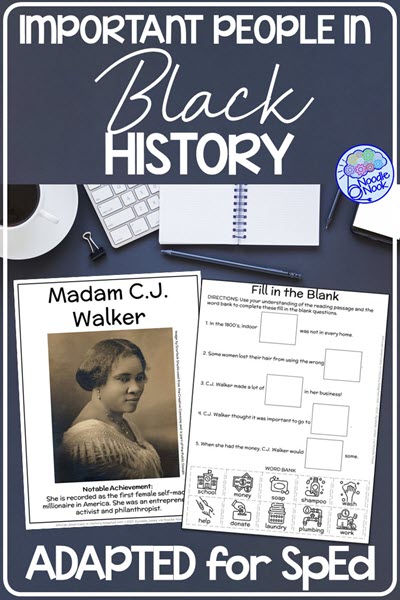
Teaching Black History to students with disabilities is important because it helps to promote inclusivity, cultural awareness, and understanding of the contributions that Black people have made to society.
For students with disabilities, learning about Black history can help to promote a sense of belonging and self-esteem by highlighting the accomplishments and successes of people who share similar experiences of discrimination and marginalization. It can also foster positive role models for students to look up to, and help them to understand their own place in history.
Plus, teaching Black history to students with disabilities helps to promote cultural awareness and understanding among all students. It exposes them to the diversity of perspectives, cultures, and experiences that make up our society and helps to promote empathy and understanding of the experiences of others.
On top of that, teaching Black history can help to challenge stereotypes, biases, and discrimination that still exist today. It can help to foster a more inclusive and equitable society by educating students about the contributions of Black people throughout history and the ongoing struggles for civil rights and social justice.
Ultimately, you’re the person who can be a bridge for students. Taking time to teach Black history to students with disabilities promotes inclusivity and cultural awareness. It also supports understanding of the contributions of Black people to society, exposes students to positive role models, and can improve self-esteem. If you want your students to learn empathy and understanding of the experiences of others, as well as challenge stereotypes, biases, and discrimination, teach black history.
Article Citation: [cite]
